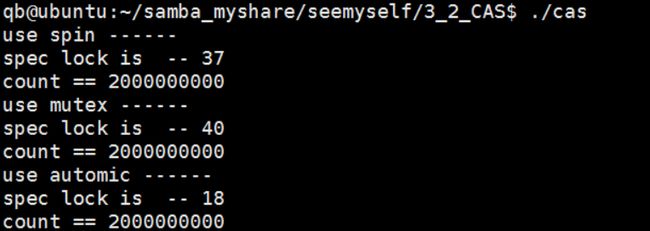C 语言的 互斥锁、自旋锁、原子操作
今天不整 GO 语言,我们来分享一下以前写的 C 代码,来看看 互斥锁,自旋锁和原子操作的 demo
互斥锁
临界区资源已经被1个线程占用,另一个线程过来访问临界资源的时候,会被CPU切换线程,不让运行后来的这个线程
适用于 锁住的内容多,(例如红黑数的增加节点操作),切换线程的代价小于等待的代价
自旋锁
临界区资源已经被1个线程占用,另一个线程过来访问临界资源的时候,相当于是一个 while(1)
不断的查看这个资源是否可用,如果可用,就进去访问临界资源,如果不可用,则继续循环访问
适用于锁住的内容少,(例如就执行++操作),切换线程的代价大于等待的代价
原子操作
执行的操作完全不可分割,要么全部成功,要么全部失败
最好的方式就是适用原子操作
实操
需求场景:
1、用10个线程分别对 count 加 100000 次, 看看结果是否是 10*100000
- main 函数中创建 10 个线程
- 线程函数中调用 inc 做数据的增加
- 分别使用 互斥锁,自旋锁,和原子操作,来进行控制
#include 如上代码还是很简单的,感兴趣的 xdm 可以自行运行,控制自己使用互斥锁,自旋锁或者是原子操作看看效果进行对比一下
2、mutex、lock、atomic 性能对比
思路还是和上面的思路类型,咱们可以通过下面的代码来实际初步看看 mutex、lock、atomic 各自的性能
//并发
//互斥锁mutex
// 如果获取不到资源会让出cpu
// 使用场景
// 共享区域执行的内容较多的情况
//自旋锁spinlock
// 如果获取不到资源,会原地自旋,忙等
// 使用场景
// 共享区域执行的内容较少的情况
//原子操作
// 不可分割
// 使用场景
// 做简单++、--操作
//
#include 结果
通过上述结果,我们可以看到,加互斥锁,自旋锁,原子操作,数据都能如我所愿的累加正确,在时间上面他们还是有一定的差异:
自旋锁 和 互斥锁 在此处的案例性能差不多,但是原子操作相对就快了很多
欢迎点赞,关注,收藏
朋友们,你的支持和鼓励,是我坚持分享,提高质量的动力
好了,本次就到这里
技术是开放的,我们的心态,更应是开放的。拥抱变化,向阳而生,努力向前行。
我是阿兵云原生,欢迎点赞关注收藏,下次见~

